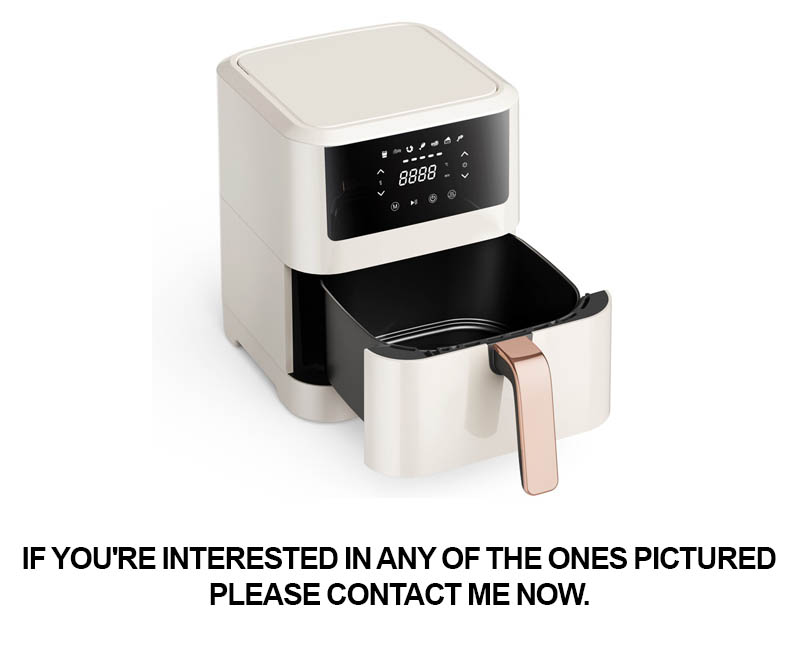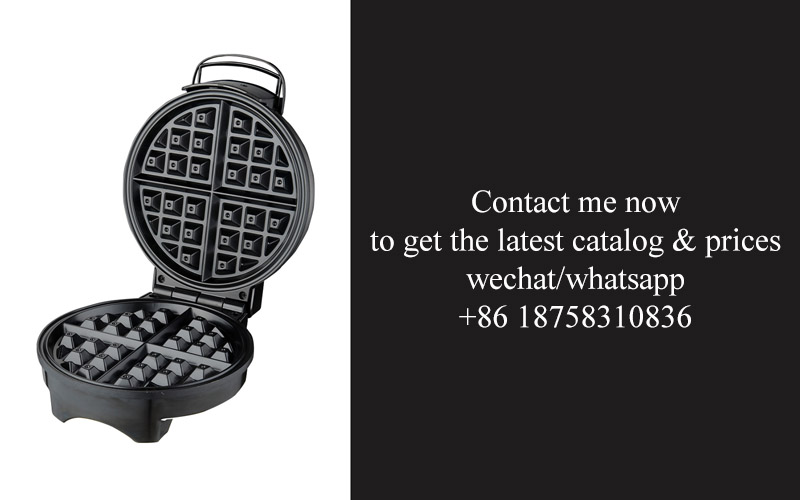Address
304 North Cardinal
St. Dorchester Center, MA 02124
Work Hours
Monday to Friday: 7AM - 7PM
Weekend: 10AM - 5PM
Address
304 North Cardinal
St. Dorchester Center, MA 02124
Work Hours
Monday to Friday: 7AM - 7PM
Weekend: 10AM - 5PM

In the ever-evolving world of e-commerce, the way we shop for kitchen appliances is changing rapidly. With the rise of small appliance drop shipping, retailers and entrepreneurs alike are discovering a new way to reach consumers and offer a wide range of products without the need for large inventory. This shift not only opens doors for innovative business models but also presents a golden opportunity for those willing to adapt to the latest market trends. Let’s delve into the intricacies of this burgeoning industry and explore the strategies that are driving success in small appliance drop shipping.
In the ever-evolving world of e-commerce, the landscape is continually reshaped by innovative business models. One such model that has gained significant traction is small appliance drop shipping, a strategy that has revolutionized the way online retailers operate. This approach has opened up new opportunities for entrepreneurs and established businesses alike, allowing them to tap into a market with high demand and low overhead.
With the rise of online marketplaces and the growing preference for convenience, consumers are increasingly looking for easy-to-use kitchen gadgets that can enhance their daily lives. This surge in demand has created a perfect storm for drop shipping, where retailers can offer a wide range of small appliances without the need for large inventories or extensive capital investment.
One of the key drivers behind the popularity of small appliance drop shipping is the convenience it offers to both retailers and customers. Retailers can now focus on marketing and customer service without the burden of managing inventory. They can offer a diverse selection of products to their customers, from high-tech kitchen gadgets to classic kitchen tools, without the risk of overstocking.
Customers, on the other hand, benefit from the vast array of choices available at their fingertips. They can compare prices, read reviews, and order products with just a few clicks, all from the comfort of their homes. This seamless shopping experience has been a game-changer for the e-commerce industry, as it has significantly reduced the barriers to entry for new businesses.
The European and American markets have been particularly receptive to this new model. In Europe, there’s a strong emphasis on quality of life, and kitchen appliances are seen as essential tools for convenience and efficiency. The American market, with its diverse demographics and love for home improvement, has also shown a keen interest in the latest kitchen gadgets.
When it comes to small appliances, innovation is key. The market is flooded with products that promise to make cooking and kitchen tasks easier, faster, and more enjoyable. From smart kitchen scales that track your nutrition to air fryers that offer healthier alternatives to fried foods, the possibilities are endless.
For those looking to capitalize on this trend, having a keen eye for innovative products is crucial. The ability to identify and source unique small appliances that stand out in the market can give retailers a competitive edge. This is where the expertise of those with a deep understanding of the industry becomes invaluable.
Leveraging China’s manufacturing prowess is another critical aspect of successful small appliance drop shipping. China is renowned for its high-quality, cost-effective manufacturing, making it an ideal source for a wide range of products. Retailers can work with Chinese manufacturers to develop custom products or source existing designs at competitive prices.
The latest industry trends and data analysis play a pivotal role in guiding retailers in their product selection and marketing strategies. By staying informed about consumer preferences, market demand, and emerging technologies, retailers can make informed decisions that align with the market’s pulse.
Sourcing top-quality small appliances from China involves careful vetting of suppliers, ensuring compliance with international standards, and maintaining clear communication throughout the supply chain. Retailers must be diligent in their due diligence to guarantee that the products they offer meet the high expectations of their customers.
Navigating the drop shipping process requires a careful balance of logistics, customer service, and marketing. Retailers must establish strong relationships with reliable suppliers, manage order fulfillment efficiently, and provide exceptional customer support to build trust and loyalty.
Marketing strategies for small appliance drop shipping should focus on highlighting the unique selling points of the products, leveraging social media platforms, and engaging with a targeted audience. Content marketing, influencer partnerships, and email campaigns can all be effective tools in driving traffic and sales.
Several case studies have showcased the success of small appliance drop shipping businesses. From niche market specialists to large-scale e-commerce platforms, these examples demonstrate the potential for growth and profitability in this sector.
In conclusion, the rise of small appliance drop shipping has undeniably changed the game for e-commerce. By embracing this model, retailers can offer a vast array of products, cater to consumer demand, and capitalize on the strengths of global manufacturing hubs like China. As the market continues to evolve, those who stay adaptable and informed will be well-positioned to thrive in this dynamic industry.

The European kitchen appliance market is a melting pot of innovation and tradition, with a keen eye for both aesthetic appeal and functional efficiency. With a history of culinary excellence, European consumers are often looking for products that not only make their cooking experience easier but also reflect their commitment to quality and sustainability.
In Germany, for instance, the focus is heavily on energy efficiency and ease of use. German kitchen appliances are known for their durable construction and cutting-edge technology, making them a top choice for households and professional chefs alike. Brands like Miele and Bosch dominate the market, offering a wide range of products that cater to every need from the smallest countertop blender to the most advanced kitchen robots.
France, on the other hand, has a reputation for creating appliances that are not just functional but also elegant. The French market is particularly fond of small kitchen appliances like toasters and coffee machines, which are often sleek and stylish, blending seamlessly into the kitchen decor. French consumers also place a high value on health and wellness, driving the demand for slow cookers, juicers, and air fryers.
In Italy, the heart of Mediterranean cuisine, kitchen appliances are as much about convenience as they are about preserving the flavors of local dishes. Appliances here often feature designs that are inspired by the rich culinary heritage, with a focus on simplicity and durability. The Italian market also sees a strong demand for products that help manage energy consumption, aligning with the country’s environmental consciousness.
Moving across the Atlantic, the American kitchen appliance market is a different beast. It’s a vast and diverse landscape, characterized by its size, its rapid adoption of new technologies, and its vast array of product offerings. The U.S. consumer is known for their love of innovation and their willingness to try new products, making it a hotbed for emerging kitchen appliance trends.
In the U.S., kitchen appliances are a big part of home décor, with many consumers choosing appliances based on their aesthetic appeal as much as their functionality. Brands like KitchenAid and GE are well-known for their stylish designs that cater to the trend-conscious consumer. Smart appliances have also seen a surge in popularity, with consumers eager to incorporate the latest in smart technology into their kitchen spaces.
American kitchens are typically larger than their European counterparts, which means there’s a demand for appliances that can handle more volume. This has led to the rise of commercial-grade appliances for residential use, offering features like convection ovens and high-capacity dishwashers that can cater to the needs of large families or frequent entertainers.
When it comes to health and wellness, the U.S. market is seeing a shift towards appliances that make healthy eating easier, such as high-powered blenders for smoothies, air fryers for crispy cooking without the excess oil, and sous vide machines for precise cooking control. Additionally, there’s a growing awareness of energy efficiency, with more consumers looking for appliances with the ENERGY STAR label.
Despite these differences, both European and American markets share certain commonalities. The importance of kitchen appliances that are user-friendly and versatile remains a key factor. The convenience of programmable settings and intuitive interfaces is highly valued, as is the integration of appliances into home automation systems.
For businesses looking to enter these markets, it’s crucial to understand the cultural nuances and the specific needs of each consumer group. For example, European consumers might prioritize eco-friendly features, while American consumers might be more focused on the latest tech innovations. By paying close attention to these details, companies can tailor their product offerings to resonate with local consumers and achieve success in both the European and American kitchen appliance markets.

In the realm of kitchen appliances, innovation is the cornerstone of success. With a keen eye on the latest trends, here are some fresh and innovative ideas that could revolutionize the way we interact with our kitchen tools.
Imagine a countertop oven that not only bakes and roasts with precision but also doubles as a built-in display for your favorite recipes. It could be equipped with a touch screen interface, allowing users to toggle between modes and even update their favorite recipes with a simple swipe. The oven’s smart capabilities could also connect to your kitchen assistant, ensuring that it preheats automatically and even sends a notification when dinner is ready.
Now, consider the refrigerator of the future. What if it were not only a cooling unit but also a hub for your entire home’s nutrition and wellness? A refrigerator that could track your dietary needs and preferences, suggest meals based on the ingredients you have, and even order groceries online? It could integrate with health apps, providing insights into your food intake and even suggesting meal plans tailored to your nutritional goals.
Introducing the multifunctional cutting board. Not just for chopping, slicing, and dicing, this cutting board could have built-in scales to weigh your ingredients, LED lighting for optimal visibility, and even a water purification system to ensure your produce is clean before you use it. With its sleek design and high-tech features, it could become the centerpiece of any kitchen.
How about a smart kettle that doesn’t just boil water but also knows your favorite beverages? It could be programmable to automatically prepare your tea or coffee, even heating the water to the perfect temperature for your preferred beverage. The kettle could also have a digital display, allowing you to see the brewing time and temperature, and it could sync with your phone for notifications when your drink is ready.
For those who love to cook, but lack the time, a robotic cooking assistant could be the perfect solution. This device could take the place of your traditional stove and oven, capable of preparing a wide array of dishes with minimal human intervention. Equipped with advanced sensors and AI, it could analyze the cooking environment, adjust cooking times and temperatures, and even clean itself after use.
In the realm of dishwashing, a new concept could be introduced with the smart dish drawer. This unit could not only wash your dishes but also dry them with a warm air cycle, reducing the need for towel drying. It could also have a sanitizing function, ensuring your dishes are germ-free before you put them away.
For the eco-conscious consumer, there’s the solar-powered kitchen appliances. From the countertop blender to the outdoor grill, solar energy could power these devices, reducing electricity consumption and carbon footprint. These appliances could even have built-in solar panels, harnessing energy directly from the sun during the day for use at night.
Lastly, let’s not forget about the kitchen sink. Imagine a sink that not only filters water but also purifies it with UV light, making it safe for drinking. It could have an integrated water softener, reducing scale buildup and extending the life of your appliances. And for those who prefer hands-free operation, a motion-activated faucet could eliminate the need for touching any surface.
These innovative ideas for kitchen appliances are just scratching the surface of what’s possible. With advancements in technology and a growing demand for smart, efficient, and user-friendly kitchen solutions, the future of cooking is sure to be exciting and filled with groundbreaking innovations.

In the realm of e-commerce, the ability to leverage manufacturing strengths is crucial for drop shipping success, and China’s robust manufacturing sector stands out as a powerhouse. From the bustling factories of Guangzhou to the high-tech zones of Shenzhen, Chinese manufacturers offer a blend of quality, affordability, and innovation that can propel drop shipping businesses forward. Here’s how you can tap into this advantage:
The sheer scale of China’s manufacturing industry is undeniable. With a workforce of over 150 million, the country produces everything from simple household items to cutting-edge technology. This vast production capacity means that drop shippers can source a wide range of kitchen appliances at competitive prices, ensuring profitability.
Chinese manufacturers are renowned for their efficiency and speed. Orders can often be fulfilled quickly, allowing drop shipping businesses to meet customer demand promptly. This rapid turnaround time is a significant advantage in the fast-paced e-commerce market, where timing can be everything.
Quality control is a vital aspect of any product, and China has made significant strides in this area. Advanced production techniques and stringent quality checks ensure that the kitchen appliances being drop shipped are reliable and meet international standards. This gives drop shippers a credibility edge when selling to customers who value quality above all else.
The cost advantage is perhaps the most compelling reason to leverage China’s manufacturing strengths. With lower labor and material costs, drop shippers can offer competitive pricing, attracting price-sensitive customers who are always on the lookout for the best deals. This cost efficiency also allows for a higher profit margin on each sale.
Chinese manufacturers are not just producing the same old items; they’re pushing the boundaries of innovation. From smart kitchen gadgets to energy-efficient appliances, there’s a constant flow of new products that can captivate consumers. Drop shippers who can offer these cutting-edge items have a unique selling point and can differentiate their brands in a crowded market.
Supply chain management in China is sophisticated and efficient, with a network of distributors and logistics providers that can handle everything from production to delivery. This means that drop shippers don’t have to worry about the complexities of importing or dealing with customs. They can focus on what they do best: selling.
Sustainability is a growing concern for consumers, and Chinese manufacturers are responding by producing more eco-friendly kitchen appliances. From biodegradable materials to energy-saving designs, these sustainable options cater to the eco-conscious consumer market, providing another avenue for drop shippers to capitalize on a trend.
Technology integration is another area where Chinese manufacturers are leading the way. Smart kitchen appliances equipped with IoT (Internet of Things) capabilities are becoming increasingly popular. Drop shippers who can offer these smart solutions can tap into the growing market of tech-savvy consumers looking to integrate their homes with the latest technology.
Collaborating with Chinese manufacturers also opens up opportunities for customization. Drop shippers can work closely with manufacturers to create branded items or modify existing designs to meet specific market demands. This level of personalization can create a loyal customer base for drop shipping businesses.
Moreover, the Chinese market itself is a treasure trove of ideas. By observing trends and consumer preferences within China, drop shippers can identify potential products that might resonate well in other markets, like Europe or the United States.
When it comes to drop shipping, the language barrier can be a challenge. However, there are numerous bilingual manufacturers and agents who can facilitate communication, ensuring that drop shippers can effectively convey their product requirements and manage their supply chain without complications.
In conclusion, China’s manufacturing prowess offers a myriad of benefits for drop shipping success. From cost savings to innovation and a streamlined supply chain, the advantages are clear. By leveraging these strengths, drop shippers can not only offer a wide array of kitchen appliances but also ensure that their products stand out in the competitive global marketplace.

In the ever-evolving landscape of the kitchen appliance industry, staying ahead of the curve is crucial. Here’s a snapshot of the latest industry trends and the data that backs them up.
Smart Integration is on the RiseHomeowners are increasingly seeking appliances that can integrate seamlessly with their smart home systems. From refrigerators that can connect to your phone to ovens that can be controlled via an app, the trend towards smart integration is undeniable. Data from the Consumer Technology Association (CTA) shows that smart kitchen appliance sales have grown by 10% annually over the past five years.
Energy Efficiency is a Top PriorityConsumers are more environmentally conscious than ever, and this extends to kitchen appliances. Energy-efficient models are not only more sustainable but also save money on utility bills in the long run. According to the U.S. Energy Information Administration, energy-efficient appliances account for a significant portion of the market, with sales expected to increase by 15% by 2025.
Health and Wellness Features are Gaining PopularityWith a growing focus on health and wellness, kitchen appliances are being designed with these values in mind. Air fryers, for example, have seen a surge in popularity due to their ability to cook with less oil, making them a healthier alternative to traditional frying methods. Data from Euromonitor International indicates that the global air fryer market has grown by 20% in the past two years.
Sustainability is a Key DriverSustainability is no longer just a buzzword; it’s a driving force in the kitchen appliance industry. Manufacturers are looking for ways to reduce their environmental impact through the use of recycled materials, longer-lasting components, and eco-friendly production processes. A report by Grand View Research found that the market for sustainable kitchen appliances is expected to grow at a compound annual growth rate (CAGR) of 8.2% from 2019 to 2025.
Customization is the New NormalConsumers are looking for appliances that can be tailored to their specific needs. This includes not just the functionality of the appliance but also its design. Customizable colors, finishes, and even modular designs that allow for easy upgrades are becoming more common. A survey by the National Kitchen & Bath Association found that 70% of consumers are interested in customizable kitchen appliances.
Health Monitoring is a New FrontierAppliances that can monitor and report on their own health and performance are becoming more prevalent. Smart cooktops that can detect when they need to be cleaned or refrigerators that can alert you when the temperature is too high are examples of this trend. According to a study by the International Data Corporation (IDC), the smart kitchen appliance market is expected to grow at a CAGR of 15% by 2024.
Urbanization and Compact LivingAs urban populations grow and living spaces become more compact, there’s a demand for smaller, more efficient appliances. Mini-fridges, countertop ovens, and compact dishwashers are becoming increasingly popular in urban settings. The Global Market Insights reports that the compact kitchen appliance market is projected to reach $5.5 billion by 2025.
E-commerce is the New Distribution ChannelThe shift to online shopping has been a game-changer for the kitchen appliance industry. Consumers are turning to e-commerce platforms for convenience and variety. According to a report by eMarketer, online kitchen appliance sales are expected to grow by 20% in the next five years.
In conclusion, the kitchen appliance industry is witnessing a transformation driven by smart technology, sustainability, and consumer preferences. Staying informed about these trends and the data behind them is essential for anyone looking to succeed in this dynamic market.

Navigating the vast landscape of Chinese manufacturers to source top-quality small appliances can be a daunting task, but with the right approach, it can be a rewarding endeavor. Here’s a guide to help you navigate through the process:
Research and Identify Your Target MarketUnderstanding the specific needs and preferences of your target market is crucial. Whether you’re aiming for the European or American market, factors like energy efficiency, design, and functionality play a significant role. Conduct thorough market research to pinpoint the types of small appliances that are in demand and the features that consumers value.
Choose the Right ManufacturerSelecting the right manufacturer is pivotal. Look for companies with a proven track record in producing small appliances. Check for certifications and compliance with international standards, such as CE or UL, which ensure the safety and quality of the products. Don’t hesitate to ask for references or samples to assess the manufacturer’s quality control.
Visit Trade Shows and ExposTrade shows and expos in China, like the Canton Fair or the China Import and Export Fair, are excellent opportunities to meet potential manufacturers. These events allow you to see products firsthand, network with suppliers, and negotiate deals. It’s a chance to evaluate the quality and range of products offered by different manufacturers.
Understand Quality Control MeasuresQuality control is non-negotiable when sourcing from China. Ensure that the manufacturer has robust quality control processes in place. This may include regular inspections, third-party audits, and adherence to ISO standards. Ask about their quality assurance procedures and how they handle defects or non-compliant products.
Negotiate Terms and ConditionsWhen dealing with manufacturers, it’s essential to negotiate favorable terms. This includes pricing, minimum order quantities (MOQs), lead times, and payment terms. Be prepared to discuss and possibly compromise on these aspects. Remember, a good relationship with your supplier can lead to better long-term deals.
Consider Sourcing Agents or DistributorsIf you’re new to sourcing from China, consider hiring a sourcing agent or distributor. These professionals have the local knowledge and connections to help you navigate the complexities of the market. They can also assist with language barriers, logistics, and ensuring that the products meet your specifications.
Inspect Production FacilitiesBefore finalizing a deal, it’s advisable to visit the manufacturer’s production facilities. This firsthand inspection can give you a better understanding of their capabilities, work environment, and overall production process. It’s an opportunity to see how the products are made and to assess the manufacturer’s commitment to quality.
Understand Logistics and ShippingLogistics is a critical factor in drop shipping. Discuss shipping methods, costs, and delivery times with your manufacturer. Ensure that they can provide reliable and cost-effective shipping solutions. Consider the impact of shipping times on your customers’ satisfaction and your business operations.
Stay Informed About Market TrendsKeep abreast of the latest market trends and consumer demands. This will help you anticipate changes and adjust your product offerings accordingly. Subscribe to industry newsletters, follow market research reports, and engage with industry forums to stay informed.
Build Long-Term RelationshipsBuilding a long-term relationship with your Chinese manufacturer is beneficial for both parties. Regular communication, feedback, and collaboration can lead to improved product quality, better pricing, and a smoother supply chain. Treat your supplier as a partner rather than just a vendor.
Remember, sourcing top-quality small appliances from China requires patience, thorough research, and a willingness to invest time in building strong relationships. By following these steps, you can set yourself up for success in the competitive world of drop shipping.

Understanding the ins and outs of the drop shipping process can be daunting, but with the right tips and tricks, it can become a seamless and profitable venture. Here’s a deep dive into the nuances of navigating this e-commerce model effectively.
Choosing the Right ProductsSelecting the right products is crucial. Look for items that have a high demand but aren’t overly saturated in the market. Consider products that offer a unique selling proposition (USP) or cater to niche markets. Research popular online marketplaces to identify what’s trending and what’s missing.
Building a Strong Supplier NetworkDeveloping a strong network of suppliers is key. Look for suppliers in China, known for its competitive pricing and vast manufacturing capabilities. Ensure they offer high-quality products and reliable shipping times. Communicate clearly with your suppliers to establish a good working relationship.
Optimizing Product ListingsYour product listings should be compelling and informative. Use high-quality images and detailed descriptions that highlight the product’s features and benefits. Incorporate keywords that potential buyers might search for to improve visibility on search engines and marketplaces.
Efficient Order ManagementEfficient order management is essential for a smooth drop shipping process. Use an order management system (OMS) to streamline the process. This system should integrate with your online store and your supplier’s system to automate order fulfillment and shipping notifications.
Customer Service ExcellenceProviding exceptional customer service is vital in drop shipping. Respond promptly to inquiries and issues. Offer multiple communication channels and consider implementing a live chat feature on your website. Be proactive in resolving any problems that arise to maintain customer satisfaction.
Leveraging Social MediaSocial media is a powerful tool for promoting your drop shipping business. Use platforms like Instagram, Facebook, and Pinterest to showcase your products. Engage with your audience by sharing tips, product reviews, and behind-the-scenes content. Utilize targeted ads to reach potential customers who are more likely to be interested in your products.
Analyzing Performance MetricsRegularly analyze your business performance to identify areas for improvement. Track metrics such as conversion rates, average order value, and customer acquisition costs. Use this data to refine your marketing strategies and optimize your product offerings.
Adapting to Market ChangesThe e-commerce landscape is constantly evolving. Stay informed about market trends and consumer preferences. Be ready to adapt your product line and marketing strategies accordingly. This agility can help you stay competitive and maintain a steady stream of sales.
Pricing StrategiesPricing is a delicate balance in drop shipping. You need to factor in the cost of the product, shipping fees, and your desired profit margin. Research competitors’ pricing and consider offering occasional promotions to attract customers. However, avoid becoming too price-sensitive, as it can undermine the perceived value of your products.
Ensuring ComplianceNavigating the legal aspects of drop shipping is important. Make sure you understand and comply with all relevant laws and regulations, including those related to import/export, product safety, and consumer rights. This includes adhering to product labeling requirements and warranty policies.
Building Brand TrustBuilding trust with your customers is crucial for long-term success. Establish your brand by creating a professional website, maintaining a consistent brand voice across all platforms, and providing exceptional customer service. Encourage customer reviews and testimonials to build credibility.
Scaling Your BusinessOnce you’ve established a solid foundation, consider scaling your business. Look for opportunities to expand your product range, explore new marketplaces, or even start drop shipping on a larger scale. Always keep an eye on your financials and operational efficiency as you grow.
By focusing on these aspects of the drop shipping process, you can navigate the complexities with confidence and set yourself up for success in the dynamic world of e-commerce. Remember, the key is to stay informed, adapt to changes, and provide value to your customers at every turn.

Understanding the nuances of marketing in the small appliance drop shipping niche is crucial for success. Here’s a deep dive into some effective strategies:
Targeted Audience Identification: To excel in marketing small appliances, it’s essential to pinpoint your audience. Research and analyze consumer preferences, focusing on demographics such as age, gender, income level, and lifestyle. For instance, if your product caters to health-conscious consumers, platforms like Instagram and Pinterest could be ideal for showcasing your appliances.
Content Marketing Powerhouse: High-quality content is king in the digital age. Create engaging blog posts, how-to guides, and product reviews that not only inform but also entertain your audience. Incorporate SEO best practices to ensure your content ranks well in search engines, driving organic traffic to your site.
Social Media Engagement: Leverage the power of social media to connect with your audience. Regularly post visually appealing content, interact with followers, and use targeted ads to reach potential customers. Platforms like Facebook, Twitter, and Instagram can be particularly effective, especially for showcasing the versatility and benefits of your small appliances.
Influencer Partnerships: Collaborate with influencers who align with your brand’s values and target demographic. Influencers can provide authentic endorsements and reach a broader audience, increasing brand visibility and credibility.
Email Marketing Magic: Build an email list and engage your subscribers with regular newsletters, exclusive offers, and product updates. Personalize your emails to create a more engaging experience, and use analytics to refine your campaigns for better open and click-through rates.
Product Showcase and Demos: Use high-quality images and videos to showcase your small appliances in action. Consider creating product demos or tutorials that highlight unique features and benefits, encouraging potential buyers to envision the appliance in their own homes.
Customer Testimonials and Reviews: Positive reviews and testimonials can significantly influence purchasing decisions. Encourage satisfied customers to leave feedback on your website, social media, and other review platforms. Highlight these reviews in your marketing materials to build trust.
Leverage E-commerce Platforms: Optimize your product listings on e-commerce platforms like Amazon, eBay, and Walmart. Use high-resolution images, detailed descriptions, and competitive pricing to stand out from the competition. Take advantage of platform-specific features like A+ content and enhanced brand content to further enhance your listings.
Google Ads and Paid Search: Invest in Google Ads to target potential customers actively searching for small appliances. Use keywords, ad extensions, and retargeting strategies to maximize your ad’s reach and effectiveness.
Collaborate with Related Industries: Partner with brands or businesses in related industries, such as kitchenware or home decor. Cross-promotion can help you tap into new audiences and create synergistic marketing opportunities.
Monitor and Analyze Performance: Regularly track the performance of your marketing campaigns using analytics tools. Analyze data such as website traffic, conversion rates, and customer acquisition costs to refine your strategies and improve ROI.
Stay Updated on Trends: Keep abreast of the latest marketing trends and technologies. Experiment with new strategies and tools that can give you a competitive edge in the dynamic world of small appliance drop shipping.
Remember, successful marketing in the small appliance drop shipping space requires a combination of creativity, persistence, and a deep understanding of your audience’s needs and preferences. By employing these strategies, you can effectively promote your products and build a loyal customer base.

In the world of e-commerce, several small appliance drop shipping businesses have found remarkable success. Let’s delve into some of these case studies to understand their strategies and the factors that contributed to their triumph.
A. The story of “Gadgets Galore” began with a focus on trendy kitchen gadgets. By identifying niche markets within the European and American appliance sectors, they were able to cater to specific customer needs. Their careful selection of products and attention to detail set them apart.
B. “Eco-Ease” took a different approach by specializing in energy-efficient small appliances. This green initiative resonated with environmentally conscious consumers, leading to a loyal customer base. Their marketing strategy emphasized sustainability, and their products were eco-friendly, which gave them a competitive edge.
C. “SmartHome Solutions” capitalized on the smart home revolution. By offering a range of connected kitchen appliances that could be controlled via smartphones or voice assistants, they tapped into a growing market segment. Their innovative approach allowed customers to experience cutting-edge technology without the high upfront cost.
D. “Appliance Attic” focused on offering a wide variety of appliances at competitive prices. Their strategy was to provide exceptional customer service, ensuring a seamless shopping experience from browsing to delivery. Their dedication to customer satisfaction led to repeat business and positive word-of-mouth referrals.
E. “Healthy Kitchen Haven” identified a gap in the market for healthy cooking appliances. They introduced a line of air fryers, juicers, and blender systems that were designed with health and wellness in mind. Their marketing campaigns highlighted the benefits of these products, which appealed to health-conscious consumers.
F. “Chef’s Choice” targeted professional chefs and aspiring culinary experts. They offered a curated selection of high-end kitchen appliances that were both functional and aesthetically pleasing. Their approach was to position their brand as a go-to source for top-quality equipment, which attracted a niche but dedicated customer base.
G. “Urban Kitchen Emporium” recognized the demand for compact and space-saving appliances in urban settings. Their offerings included portable appliances, countertop ovens, and mini fridges that were perfect for small apartments. Their marketing focused on the convenience and efficiency of these products, which appealed to busy city dwellers.
H. “Appliance Alley” built its reputation on offering a vast inventory at unbeatable prices. They leveraged bulk purchasing power to provide discounts and deals, which attracted budget-conscious shoppers. Their website was user-friendly, making it easy for customers to find exactly what they needed.
I. “Culinary Creations” took a unique approach by combining e-commerce with a subscription service. Customers could sign up for monthly boxes that included a variety of kitchen gadgets and tools. This model not only generated recurring revenue but also kept customers engaged and excited about their shopping experience.
J. “Appliance Artisans” focused on customizing appliances to meet individual customer preferences. They offered a range of finishes, features, and even personalized engraving. This level of customization set them apart and allowed them to cater to a highly discerning market segment.
K. “Global Gourmet” expanded its market reach by sourcing appliances from various countries, offering a diverse selection to their customers. They emphasized the cultural significance of each product, which added an element of curiosity and discovery to their shopping experience.
L. “Appliance Advocates” made a commitment to transparency and ethical sourcing. They provided detailed information about the origins of their products and the working conditions of the manufacturers. This approach appealed to customers who valued social responsibility and were willing to pay a premium for it.
M. “Kitchen Kudos” focused on creating a community around their brand. They hosted cooking challenges, shared recipes, and provided cooking tips on their social media channels. This community-building strategy not only increased engagement but also helped customers feel connected to the brand.
N. “Appliance Achievers” leveraged technology to enhance their drop shipping process. They implemented a sophisticated inventory management system that ensured accurate tracking and timely delivery. Their use of data analytics helped them anticipate customer needs and streamline their operations.
O. “Appliance Alchemy” combined the principles of marketing and customer service to create a magical shopping experience. They offered personalized recommendations, excellent customer support, and a seamless return process. This holistic approach made them a favorite among repeat customers.
P. “Appliance Ambassadors” took their marketing efforts global by engaging in cross-border partnerships. They expanded their reach by collaborating with influencers and brands in different countries, which helped them tap into new markets and customer segments.
Q. “Appliance Achievers” recognized the importance of sustainability and incorporated eco-friendly practices into their business operations. They used recycled packaging, offered carbon-neutral shipping options, and supported eco-friendly initiatives. This commitment to sustainability resonated with environmentally conscious consumers.

In the ever-evolving landscape of kitchen appliance retail, embracing the future means staying ahead of the curve. From innovative designs to smart technology integration, the future of kitchen appliances is not just about functionality but also about connectivity and sustainability. Here are some key insights into the future trends shaping this industry:
Smart Kitchen Appliances Are the New NormModern kitchen appliances are increasingly becoming smart, offering features like voice control, remote monitoring, and energy efficiency. Consumers are gravitating towards appliances that can be integrated into their smart homes, providing convenience and control at their fingertips.
Sustainability and Eco-Friendly MaterialsThe future of kitchen appliances will also be marked by a strong emphasis on sustainability. Eco-friendly materials, energy-saving technologies, and appliances designed to reduce waste are becoming more prevalent. Consumers are more environmentally conscious than ever, and brands that align with these values are likely to gain a competitive edge.
Personalization and CustomizationCustomization isn’t just a buzzword; it’s a reality in the kitchen appliance market. Appliances that can be tailored to individual needs, whether it’s through adjustable settings or modular designs, are becoming increasingly popular. Personalization is not just about looks; it’s about functionality that caters to the unique cooking styles and preferences of consumers.
Technology Integration and ConnectivityKitchen appliances are becoming more connected, allowing for seamless integration with other smart devices and systems. This means that appliances can be controlled via smartphone apps, offering convenience and efficiency. The rise of the Internet of Things (IoT) is making kitchen appliances smarter and more intuitive.
Sustainability Through Energy EfficiencyEnergy efficiency is no longer a luxury but a necessity. Newer appliances are designed to use less energy while maintaining or improving performance. This not only saves money for consumers but also contributes to a smaller carbon footprint.
Health and Wellness FocusHealth and wellness are top of mind for many consumers, and this is influencing the design and functionality of kitchen appliances. For instance, appliances that help prepare meals with fewer additives, or that have features to preserve the nutritional value of food, are becoming more popular.
Simplified Installation and User-Friendly DesignAs technology advances, the installation process for kitchen appliances is becoming simpler. Manufacturers are focusing on user-friendly designs that make it easier for consumers to install and maintain their appliances. This shift towards ease of use is crucial for ensuring customer satisfaction.
Globalization of the MarketThe kitchen appliance market is becoming more globalized, with brands from various countries vying for market share. This globalization has led to a wider variety of products and more competitive pricing, which benefits consumers.
E-commerce and Direct-to-Consumer ModelsE-commerce is changing the way appliances are sold. Direct-to-consumer models are becoming more common, allowing manufacturers to sell directly to customers, bypassing traditional retail channels. This approach often results in lower prices and a more personalized shopping experience.
Innovation in Cleaning and HygieneInnovation isn’t just about cooking; it’s also about cleaning. Appliances that can help maintain a clean and hygienic kitchen are becoming more advanced, with features like self-cleaning functions and antimicrobial materials.
Brand Collaboration and PartnershipsBrands are looking to collaborate and form partnerships to create innovative and unique appliance offerings. This could involve merging technologies, sharing expertise, or co-creating new products that meet the evolving needs of consumers.
In conclusion, the future of kitchen appliance retail is marked by a combination of smart technology, sustainability, personalization, and connectivity. As consumers continue to demand more from their kitchen appliances, the industry must adapt and innovate to meet these expectations. The companies that can successfully navigate this landscape will be the ones that lead the way in the next generation of kitchen appliances.